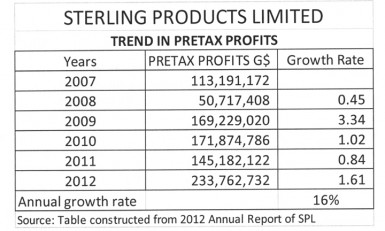Variable performance
Sterling Products Limited (SPL) is about to complete its ninth month of operation in 2013 and its economic performance might well remain an enigma to its shareholders as the company moves towards its 59th Annual General Meeting next year. SPL, which is part of the Beharry Group of companies, is a monopoly in the domestic market with its competition coming primarily from imports of products similar to what it produces. SPL sells between 72 to 75 per cent of its output in the domestic market while the rest is exported. While export sales grew by 11 per cent in 2012, export volumes appear to have grown by 9 per cent in the reporting period. Despite the generally good reports, SPL has been turning in variable performances over the past six years as could be gleaned from the table below. The financing profile of the company shows that the management prefers to do things alone, and one could only wonder what to expect the next time management discloses its economic performance to the public.
The midterm economic report presented to the nation last month with recorded growth of 3.9 per cent should leave followers of the company thinking positively about SPL. But one has to remain cautious because the trend line of this company’s performance while it slopes upwards does so at highly variable speeds. While there were years of impressive pretax growth as in 2009, 2010 and in 2012, the overall trend in the rate of change in the pretax returns to the company has not been that convincing. Pretax profits are preferred in this discussion since they contain all the elements that matter to a rational assessment of the conduct of the business. The 55 per cent decline in the pretax growth rate of 2008, the barely perceptible growth in 2010 and the 16 per cent decline in 2011 are enough to prompt an inquiry as does the exceptional 234 per cent growth of 2009. The behaviour of these figures is therefore a reasonable indicator of things that are going on in the company and, when their component parts are disaggregated, also helps one to form an opinion on the business strategy of the enterprise.
of impressive pretax growth as in 2009, 2010 and in 2012, the overall trend in the rate of change in the pretax returns to the company has not been that convincing. Pretax profits are preferred in this discussion since they contain all the elements that matter to a rational assessment of the conduct of the business. The 55 per cent decline in the pretax growth rate of 2008, the barely perceptible growth in 2010 and the 16 per cent decline in 2011 are enough to prompt an inquiry as does the exceptional 234 per cent growth of 2009. The behaviour of these figures is therefore a reasonable indicator of things that are going on in the company and, when their component parts are disaggregated, also helps one to form an opinion on the business strategy of the enterprise.
Parity in the gross margin
 The most important goal of any company is to increase the wealth of its shareholders. It seeks to achieve that goal by using the money provided by its customers to meet all of its costs in as efficient a manner as possible. The business strategy of a company therefore is usually directed at accomplishing an expansion in output and sales while keeping costs under control. During the operating cycle, that period in which assets are expected to be turned into cash, sold or consumed, the company must be able to demonstrate an ability to control production costs while collecting cash from sales in the shortest time possible. SPL seems to have done a very good job of fulfilling its cash collection requirement and leaves a measure of doubt about its cost control efforts. From 2010 to 2012, SPL managed to keep production costs steady at 76 per cent of its sales revenue. The details of its production costs are not readily discernible from the annual reports of the company. But the expansion in output in 2012 reportedly saw conversion costs moving higher. Parity in the gross margin ratio with 2011 and prior years could only be accomplished by making adjustments in selling price in 2012.
The most important goal of any company is to increase the wealth of its shareholders. It seeks to achieve that goal by using the money provided by its customers to meet all of its costs in as efficient a manner as possible. The business strategy of a company therefore is usually directed at accomplishing an expansion in output and sales while keeping costs under control. During the operating cycle, that period in which assets are expected to be turned into cash, sold or consumed, the company must be able to demonstrate an ability to control production costs while collecting cash from sales in the shortest time possible. SPL seems to have done a very good job of fulfilling its cash collection requirement and leaves a measure of doubt about its cost control efforts. From 2010 to 2012, SPL managed to keep production costs steady at 76 per cent of its sales revenue. The details of its production costs are not readily discernible from the annual reports of the company. But the expansion in output in 2012 reportedly saw conversion costs moving higher. Parity in the gross margin ratio with 2011 and prior years could only be accomplished by making adjustments in selling price in 2012.
Value-added output
The price adjustment was most likely downwards in an effort to sell more of its output. The value-added output of the company grew at an average rate of 13 per cent from 2010 to 2012. This change in value also reflects an expansion of output during the period when measured against output in 2010. While moving by a mere one per cent in 2011, output expanded significantly, between 10 to 15 per cent, in 2012. This increase in output could be attributed to what the company acknowledges as “sustained demand seen during the year for Golden Cream Margarine, Mighty Foam Powdered Detergent, Dishwashing liquid, Igloo Ice Cream, Fresh Fruit Flavored Ice Cream, Novelties Ice Cream and Royal Ripple Premium Ice Cream.”
Pricing strategy

The Lucas Stock Index (LSI) rose by 1.28 per cent in trading during the third week of September 2013. Trading involved six companies in the LSI with a total of 72,443 shares in the index changing hands this week. There were two Climbers and one Tumbler while the stocks of three companies remained unchanged. The Climbers were Demerara Distillers Limited (DDL) which rose 0.61 per cent on the sale of 38,944 shares and Republic Bank Limited (RBL) which rose 8.7 per cent on the sale of 2,000 shares. The Tumbler was Demerara Tobacco Company (DTC) which fell 5 per cent on the sale of 600 shares. The stocks of Banks DIH (DIH) remained unchanged on the sale of 25,500 shares, and so did those of Guyana Bank for Trade and Industry (BTI) and Sterling Products Limited (SPL) which sold 2,616 and 2,783 shares respectively.
The statement about demand, it appears, might be an attempt to render its pricing as stable in the face of the strategic moves the company had to make to sell its increased output, including in the overseas markets in which it competes. Adjusting for cost movement, SPL appears to have reduced prices by about five per cent in an effort to sell its increased output. This might have been part of its strategy to penetrate the Caribbean markets of Barbados and Trinidad and Tobago with specific brands of its product. The pricing strategy paid off because the substitution effect generated by the lower price overpowered the loss from the income effect and helped to increase revenues by an estimated 11 per cent. As a consequence, SPL was able also to keep an average of 25 per cent of the revenues generated from customers to finance its other operating costs in 2012. Some additional evidence that the business strategy is working is seen in the relationship between the resources used to run the business and the financing provided by its customers.
Asset turnover
The metric that best describes that relationship is the asset turnover. What is evident is that SPL was able to increase the revenues without having to expand its asset base too much. Except for the revaluation, the ratio of productive assets remained stable relative to total assets. The efficiency of SPL’s asset management is most notable in its current assets, particularly the cash and receivables management since these showed the greatest favourable movement. For the three years for which this writer has data, SPL was able to increase its efficiency in cash by $203 million in 2012 as against 2010. The number of days that were invested in cash and cash equivalents decreased from 45 days to 23 days. Receivables management also reflected improved efficiency but not as much as cash and cash equivalents. However, the number of days that were invested in receivables declined from 41 to 37. Though relatively small, this efficiency contribution amounted to an additional $39 million available to shareholders of the company.
Short-term behaviour
The discussion of the short-term behaviour of SPL reveals that the business strategy of SPL is producing desired results. But it is equally useful to understand how the long-term investment and financing decisions of SPL fit into the overall business strategy that it has been pursuing. An important variable in this part of the analysis is the working capital of SPL. Here, the current assets can be interpreted as the short-term investments associated with SPL’s operating cycle and the current liabilities as the short-term financing provided by suppliers and other creditors. Where the long-term interests of the company are concerned, working capital is that part of investment in day-to-day operations that is being financed by long-term finances. SPL’s long-term investment in working capital decreased from 122 days net sales to 90 days of net sales, suggesting that it poses no major problem for management.
Self-direction and management
The issuance of stock is not a factor in the long-term financing of the company and the importance of external equity financing has diminished over time. Further, the company has no need and shows no interest in long-term external debt financing. The company is therefore proud that management alone determines the direction and future of the company, even though SPL has been increasing its capacity to leverage external financing that could help grow the company faster. Instead, management prefers to go it alone and hold a conservative line as could be surmised from the following remarks. ”Total Capital expenditure for the year amounted to G$251.6 M… This amount was financed from funds generated internally.” An important contributing factor to the long-term financing capacity of the company is the interest free money available through special tax rules for depreciation. These funds represent about eight per cent of the internal equity financing capacity of the company, and add to its ability and motivation for self-direction and exclusive control over the business by its management.









